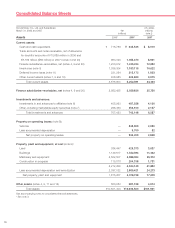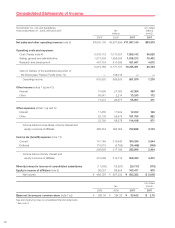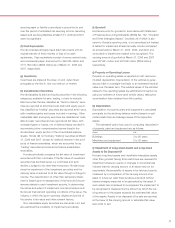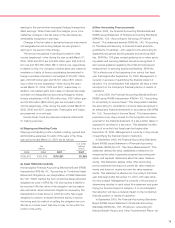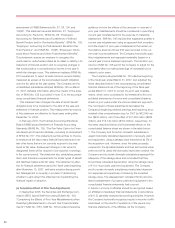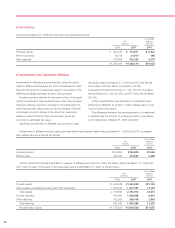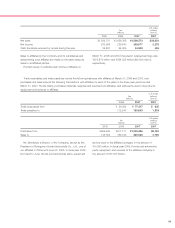Honda 2007 Annual Report Download - page 82
Download and view the complete annual report
Please find page 82 of the 2007 Honda annual report below. You can navigate through the pages in the report by either clicking on the pages listed below, or by using the keyword search tool below to find specific information within the annual report.
80
amendment of FASB Statements No. 87, 88, 106, and
132(R)”. This statement amends SFAS No. 87, “Employers’
Accounting for Pensions”, SFAS No. 88, “Employers’
Accounting for Settlements and Curtailments of Defined
Benefit Pension and for Termination Benefits”, SFAS No. 106,
“Employers’ Accounting for Postretirement Benefits Other
Than Pensions”, and SFAS No. 132(R), “Employers’ Disclo-
sures about Pensions and Other Postretirement Benefits”.
This statement requires an employer to recognize the
overfunded or underfunded status as an asset or liability in its
statement of financial position and to recognize changes in
that funded status in comprehensive income in the year in
which the changes occur. This statement replaces SFAS No.
87’s requirement to report at least minimum pension liability
measured as excess at the accumulated benefit obligation
over the fair value at the plan assets. The Company and its
consolidated subsidiaries adopted SFAS No.158 on March
31, 2007. Detailed information about the impact of the adop-
tion of SFAS No. 158 is provided in note 13 to the accompa-
nying consolidated financial statements.
This statement also changes the date at which benefit
obligations are to be measured to the date of the year-end
statement of financial position. The measurement provisions
of this statement are effective for fiscal years ending after
December 15, 2008.
In February 2007, the Financial Accounting Standards
Board (FASB) issued Statement of Financial Accounting
Standards (SFAS) No. 159, “The Fair Value Option for Finan-
cial Assets and Financial Liabilities—including an amendment
of SFAS No.115”. This statement permits entities to choose
to measure at fair value many financial instruments and cer-
tain other items that are not currently required to be mea-
sured at fair value. Subsequent changes in fair value for
designated items will be required to be reported in earnings
in the current period. The statement also establishes presen-
tation and disclosure requirements for similar types of assets
and liabilities measured at fair value. The statement is effec-
tive for financial statements issued for fiscal years beginning
after November 15, 2007, with early adoption being permit-
ted. Management is currently in process of determining
whether to early adopt this statement and quantifying the
financial impact of adoption.
(u) Cumulative Effect of Prior Year Adjustments
In September 2006, the Securities and Exchange Com-
mission (SEC) issued Staff Accounting Bulletin No. 108,
“Considering the Effects of Prior Year Misstatements when
Quantifying Misstatements in Current Year Financial State-
ments” (“SAB No. 108”). SAB No. 108 provides interpretive
guidance on how the effects of the carryover or reversal of
prior year misstatements should be considered in quantifying
current year misstatements for the purpose of materiality
assessment. SAB No. 108 requires that registrants quantify a
current year misstatement using an approach that considers
both the impact of prior year misstatements that remain on
the balance sheet and those that were recorded in the cur-
rent year income statement. The Company historically quan-
tified misstatements and assessed materiality based on a
current year income statement approach. The transition pro-
visions of SAB No. 108 permit the Company to adjust for the
cumulative effect on retained earnings of immaterial errors
related to prior years.
The Company adopted SAB No. 108 effective beginning
of the fiscal year ended March 31, 2007, and adjusted the
items described below in the accompanying consolidated
financial statements as of the beginning of the fiscal year
ended March 31, 2007 to correct the prior year misstate-
ments, which were considered to be immaterial to the con-
solidated statements of income and consolidated balance
sheets in prior years under the income statement approach.
The net impact of these adjustments decreased the
Company’s beginning retained earnings and beginning accu-
mulated other comprehensive loss for 2007 by ¥62,640 mil-
lion ($530 million), net of tax effect of ¥31,235 million ($265
million), and ¥18,149 million ($153 million), respectively, for
the items described below and incremental effects on the
consolidated balance sheet are shown in the table below:
1. The Company and its certain domestic subsidiaries in
Japan historically calculated depreciation of property, plant
and equipment, using a salvage value determined as 5% of
the acquisition cost. However, since the sales proceeds
received for the liquidated assets and their economical value
at the end of its useful life historically have been nominal, the
Company and its certain domestic subsidiaries assessed the
adequacy of the salvage value and concluded that they
should have calculated depreciation using the salvage value
of ¥1 for its properly, plant and equipment. The Company
and its certain domestic subsidiaries recalculated deprecia-
tion expenses retrospectively considering the corrected
salvage value. The reassessment indicated that an accumu-
lated overstatement of property, plant and equipment in the
consolidated financial statements had occured.
2. Equity in income of affiliates should be recognized based
on affiliates’consolidated financial statements in accordance
with U.S. generally accepted accounting principles. However,
the Company historically recognized equity in income of affili-
ates based on the results of operations of the parent-only
financial statements of the affiliates, as the Company


